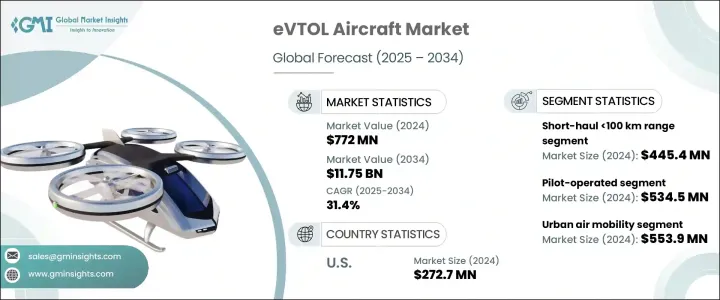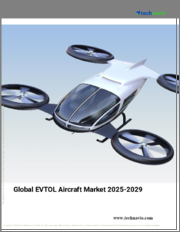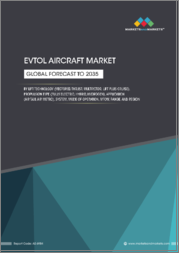
|
시장보고서
상품코드
1740913
eVTOL 항공기 시장 : 기회, 성장 촉진요인, 산업 동향 분석 및 예측(2025-2034년)eVTOL Aircraft Market Opportunity, Growth Drivers, Industry Trend Analysis, and Forecast 2025 - 2034 |
||||||
세계의 eVTOL 항공기 시장 규모는 2024년 7억 7,200만 달러로 평가되었고, 2034년에는 117억 5,000만 달러에 이를 것으로 예측되며, CAGR 31.4%로 성장할 전망입니다.
도시화의 빠른 속도로 인해 도로 혼잡이 심화되면서 기존 교통 수단의 효율성이 떨어지고 있습니다. 이러한 변화로 인해 대체 모빌리티 옵션에 대한 관심이 높아지고 있으며, eVTOL은 짧고 효율적인 지점 간 이동을 위한 선도적인 솔루션으로 부상하고 있습니다. 정부와 도시 계획가들은 최신 인프라 개발의 일환으로 이러한 항공기를 적극적으로 장려하고 있으며, 민관 파트너십을 활용하여 실행을 지원하고 있습니다. 또한 최적화된 도시 교통 시스템이 전반적인 경제 성과에 기여할 수 있다는 인식이 확산되고 있습니다. 한편, 지속가능성을 향한 전 세계적인 노력으로 전기 구동 모빌리티로의 전환이 가속화되면서 오늘날 친환경을 중시하는 시장에서 eVTOL 기술의 중요성이 더욱 높아지고 있습니다.

하지만 몇 가지 도전 과제가 시장의 성장 궤도에 제동을 걸고 있습니다. 철강, 알루미늄, 항공우주 부품 등 주요 수입 자재에 부과된 관세는 생산 비용을 상승시켰으며, 특히 국제 공급망에 의존하는 제조업체에 영향을 미쳤습니다. 이러한 비용 증가로 인해 특히 가격에 매우 민감한 시장에서 경쟁력 있는 가격을 제시하기가 더 어려워졌습니다. 생산 비용 증가는 소비자에게도 전가되어 소매 가격 상승의 원인이 되고 있습니다. 또한 공급망 중단으로 인해 최종 배송이 지연되어 구매자에게 불확실성을 야기하고 채택률이 둔화되고 있습니다. 이러한 장애물에도 불구하고 해외 경쟁이 줄어들면서 국내 제조업체는 성장의 여지가 더 많아져 이점을 누리고 있습니다. 장기적으로는 더 많은 기업이 국내 소싱으로 전환하고 공급망을 재구성하여 글로벌 혼란에 덜 취약해짐에 따라 업계가 재조정될 것으로 예상됩니다.
| 시장 범위 | |
|---|---|
| 시작 연도 | 2024년 |
| 예측 연도 | 2025-2034년 |
| 시작 금액 | 7억 7,200만 달러 |
| 예측 금액 | 117억 5,000만 달러 |
| CAGR | 31.4% |
eVTOL은 지상 교통의 비효율성에 대한 실질적인 해답으로 점점 더 주목받고 있습니다. 도로 교통을 우회하고 신속하고 직접적인 경로를 가능하게 하는 이 항공기는 특히 도시 통근자들에게 매력적인 가치 제안을 제공합니다. 이 항공기는 수직 이착륙이 가능하도록 설계되어 공간이 제한된 도시 환경에 이상적입니다. 각국 정부도 도시 이동성을 혁신할 수 있는 잠재력을 인정하고 장기 교통 계획에 직항 노선을 통합하고 있습니다. 청정 교통수단이 국내외적으로 우선순위가 되면서 전기 항공은 규제 지원과 민간 투자를 통해 지지를 얻고 있습니다.
배터리 기술과 전기 추진 시스템의 혁신은 eVTOL의 상업적 실용성을 높이는 데 중추적인 역할을 하고 있습니다. 리튬 이온 배터리와 새로운 고체 배터리의 발전으로 비행 거리가 연장되고, 안전성이 향상되며, 탑재 용량이 증가하고 있습니다. 동시에 새로운 소재와 효율적인 추진 설계가 전반적인 운영 비용을 낮추고 있습니다. 이러한 개선으로 인해 도심 항공 모빌리티의 장기적인 잠재력을 보고 있는 항공우주 및 자동차 분야의 주요 업체들이 투자를 유치하고 있습니다. 또한 개발자들은 경량 복합 소재를 사용하고 에너지 효율적인 모터 기술을 연구하여 항공기 성능을 향상시키는 동시에 지속 가능성 목표를 달성하기 위해 노력하고 있습니다.
거리별로는 단거리(최대 100km) 부문이 2024년 4억 4,540만 달러를 차지했습니다. 이 카테고리는 도시 내 및 지역 항공 여행, 특히 빠르고 빈번한 비행이 필요한 사용 사례에 가장 실용적인 솔루션으로 각광받고 있습니다. 이 항공기는 항공 택시, 의료 운송 및 물류와 같은 분야에 적합합니다. 배터리 개선은 비행 시간을 연장하는 동시에 탑재 용량을 늘리는 데 도움이 되고 있습니다. 정부와 민간 기업들은 이착륙장과 같은 인프라 지원에 투자하고 있지만 소음, 규제, 대중의 신뢰와 관련된 문제는 여전히 해결해야 할 과제입니다.
자율성별로 분류하면, 2024년에는 파일럿이 조종하는 eVTOL이 5억 3,450만 달러의 가치로 시장을 주도했습니다. 이러한 모델은 대중의 신뢰가 높고 규제 승인이 원활하기 때문에 상업적 배치의 초기 단계에서 선호됩니다. 숙련된 조종사가 필요하기 때문에 운영 비용이 증가하지만, 안전과 통제가 보장되기 때문에 기술이 더 널리 수용될수록 중요합니다. 기업들은 운영자를 지원하고 업무량을 줄이기 위해 사용자 친화적인 인터페이스와 반자동 조종석 시스템을 우선시하고 있습니다. 이러한 항공기는 완전한 자율성을 향한 디딤돌 역할을 하며, 궁극적으로 더 발전된 시스템을 지원할 수 있는 신뢰성과 운영 데이터를 구축하는 데 도움이 됩니다.
지역별 수요 측면에서 미국은 2024년 2억 7,270만 달러의 가치로 시장을 지배했습니다. 미국은 기술 혁신을 포용하는 문화에 힘입어 기존 항공우주 기업과 민첩한 스타트업으로 구성된 강력한 생태계를 제공합니다. 배터리 및 자동화 기술에 초점을 맞춘 연구 노력이 시장을 발전시키고 있습니다. 항공 교통 관제 및 대중의 정서와 같은 통합 과제가 남아 있지만, 모빌리티 기업과의 파트너십 및 인프라 투자를 통해 eVTOL 서비스 상용화에 대한 중국의 의지는 분명합니다.
제조업체들은 에너지 효율적인 설계, 항공기 소음 감소, 자동화 통합에 투자하여 경쟁력을 유지하기 위한 전략적 조치를 취하고 있습니다. 일부는 항공 교통 관리 및 예측 유지보수에 AI를 활용하여 운영을 간소화하고 있습니다. 화물, 의료 운송, 프리미엄 항공 여행과 같은 틈새 부문을 위한 맞춤화가 주요 트렌드가 되고 있습니다. 동시에 합병, 파트너십, 규제 당국과의 협업은 기업이 운영을 확장하고 인증 프로세스를 탐색하는 데 도움이 되고 있습니다. 디지털 트윈과 로봇 공학 같은 새로운 기술도 생산 라인 전반에서 비용을 절감하고 안전성을 높이는 데 도움이 되고 있습니다.
목차
제1장 조사 방법과 범위
제2장 주요 요약
제3장 업계 인사이트
- 생태계 분석
- 트럼프 정권의 관세 분석
- 무역에 미치는 영향
- 무역량의 혼란
- 보복 조치
- 업계에 미치는 영향
- 공급측의 영향
- 가격 변동
- 공급망 재구성
- 생산 비용에 미치는 영향
- 수요측의 영향
- 최종 시장에의 가격 전달
- 시장 점유율 동향
- 소비자의 반응 패턴
- 공급측의 영향
- 영향을 받는 주요 기업
- 전략적인 업계 대응
- 공급망 재구성
- 가격 설정 및 제품 전략
- 정책관여
- 전망과 향후 검토 사항
- 무역에 미치는 영향
- 업계에 미치는 영향요인
- 성장 촉진요인
- 도시 혼잡과 효율적인 모빌리티에 대한 필요성
- 배터리 및 전기 추진 기술의 발전
- 환환경 지속 가능성 및 배기가스 감축 목표
- 투자 및 전략적 파트너십 증가
- 업계의 잠재적 위험 및 과제
- 높은 개발 비용
- 규제 당국의 승인 지연
- 성장 촉진요인
- 성장 가능성 분석
- 규제 상황
- 기술의 상황
- 장래 시장 동향
- 갭 분석
- Porter's Five Forces 분석
- PESTEL 분석
제4장 경쟁 구도
- 소개
- 기업의 시장 점유율 분석
- 주요 시장 기업의 경쟁 분석
- 경쟁 포지셔닝 매트릭스
- 전략 대시보드
제5장 시장 추계 및 예측 : 범위별(2021-2034년)
- 주요 동향
- 단거리 100 km 미만
- 중거리 100-300 km
- 장거리 300km 이상
제6장 시장 추계 및 예측 : 자율성별(2021-2034년)
- 주요 동향
- 파일럿 조종
- 원격 조종
- 완전 자율형
제7장 시장 추계 및 예측 : 용도별(2021-2034년)
- 주요 동향
- 도시형 항공 모빌리티
- 구급 헬리콥터
- 관광 및 레저
- 기타
제8장 시장 추계 및 예측 : 지역별(2021-2034년)
- 주요 동향
- 북미
- 미국
- 캐나다
- 유럽
- 독일
- 영국
- 프랑스
- 스페인
- 이탈리아
- 네덜란드
- 아시아태평양
- 중국
- 인도
- 일본
- 호주
- 한국
- 라틴아메리카
- 브라질
- 멕시코
- 아르헨티나
- 중동 및 아프리카
- 사우디아라비아
- 남아프리카
- 아랍에미리트(UAE)
제9장 기업 프로파일
- Joby Aviation
- Archer Aviation Inc.
- EHang
- Volocopter
- Lilium
- BETA Technologies
- Vertical Aerospace
- Wisk Aero
- Supernal, LLC
- Eve Air Mobility
- Autoflight
- Overair, Inc.
- AeroMobil
- SkyDrive Inc.
- Jaunt Air Mobility LLC.
- Urban Aeronautics
- Bell Textron Inc.
- DORONI AEROSPACE INC. ALL
- Guangdong Huitian Aerospace Technology Co,Ltd.
The Global eVTOL Aircraft Market was valued at USD 772 million in 2024 and is estimated to grow at a CAGR of 31.4% to reach USD 11.75 billion by 2034. The rapid pace of urbanization is driving up road congestion, making traditional transport modes less efficient. This shift is prompting significant interest in alternative mobility options, with eVTOLs emerging as a leading solution for short, efficient, point-to-point travel. Governments and city planners are actively encouraging these aircraft as part of modern infrastructure development, leveraging public-private partnerships to support implementation. There's also growing acknowledgment that an optimized urban transport system can contribute to overall economic performance. Meanwhile, the global push for sustainability is accelerating the transition toward electric-powered mobility, further boosting the relevance of eVTOL technology in today's eco-conscious markets.

However, certain challenges have tempered the market's growth trajectory. Tariffs imposed on key imported materials such as steel, aluminum, and aerospace components have driven up production costs, particularly impacting manufacturers relying on international supply chains. These increased costs have made it harder for companies to offer competitive pricing, especially in a market that is highly price sensitive. Higher production expenses are also being passed on to consumers, causing retail prices to climb. Additionally, supply chain interruptions have delayed final deliveries, creating uncertainty for buyers and slowing adoption rates. Despite these hurdles, local manufacturers have seen an advantage, as reduced foreign competition gives them more room to grow. Over the long term, the industry is expected to recalibrate, with more companies turning to domestic sourcing and reconfiguring supply chains to become less vulnerable to global disruptions.
| Market Scope | |
|---|---|
| Start Year | 2024 |
| Forecast Year | 2025-2034 |
| Start Value | $772 Million |
| Forecast Value | $11.75 Billion |
| CAGR | 31.4% |
eVTOLs are increasingly being viewed as a practical answer to the inefficiencies of ground-based transportation. Their ability to bypass road traffic and enable swift, direct routes offers a compelling value proposition, especially for urban commuters. These aircraft are designed to land and take off vertically, making them ideal for city environments with limited space. Governments are also acknowledging their potential to transform urban mobility and are integrating them into long-term transportation planning. As clean transportation becomes a national and international priority, electric aviation is gaining support through both regulatory backing and private investment.
Innovation in battery technology and electric propulsion systems is playing a pivotal role in making eVTOLs more commercially viable. Advances in lithium-ion and emerging solid-state batteries are extending flight range, enhancing safety, and increasing payload capacity. At the same time, new materials and efficient propulsion designs are lowering overall operational costs. These improvements are attracting investments from major players in the aerospace and automotive sectors, who see long-term potential in urban air mobility. Developers are also using lightweight composites and exploring energy-efficient motor technologies to enhance aircraft performance while meeting sustainability goals.
By range, the short-haul (up to 100 km) segment accounted for USD 445.4 million in 2024. This category is gaining momentum as the most practical solution for intra-city and regional air travel, especially for use cases requiring quick, frequent flights. These aircraft are well-suited for applications like air taxis, medical transportation, and logistics. Battery improvements are helping extend flight times while increasing payload capacity. Governments and private firms are investing in supporting infrastructure like takeoff and landing zones, though challenges related to noise, regulation, and public trust still need to be addressed.
When broken down by autonomy, pilot-operated eVTOLs led the market in 2024 with a valuation of USD 534.5 million. These models are preferred during the initial stages of commercial deployment due to greater public trust and smoother regulatory approval. While the requirement for trained pilots increases operational costs, it also ensures safety and control, which is critical as the technology gains broader acceptance. Companies are prioritizing user-friendly interfaces and semi-automated cockpit systems to support operators and reduce workload. These aircraft serve as a stepping stone to full autonomy, helping to build credibility and operational data that will eventually support more advanced systems.
In terms of regional demand, the U.S. dominated the market with a valuation of USD 272.7 million in 2024. The country offers a strong ecosystem of legacy aerospace firms and agile startups, supported by a culture that embraces technological innovation. Research efforts focused on battery and automation technologies are pushing the market forward. While integration challenges like air traffic control and public sentiment remain, the country's commitment to commercializing eVTOL services is evident through partnerships with mobility companies and infrastructure investments.
Manufacturers are taking strategic steps to remain competitive by investing in energy-efficient designs, reducing aircraft noise, and integrating automation. Some are leveraging AI for air traffic management and predictive maintenance to streamline operations. Customization for niche sectors like cargo, medical transport, and premium air travel is becoming a key trend. At the same time, mergers, partnerships, and collaborations with regulatory authorities are helping firms scale operations and navigate certification processes. Emerging technologies like digital twins and robotics are also helping reduce costs and increase safety across production lines.
Table of Contents
Chapter 1 Methodology and Scope
- 1.1 Market scope and definitions
- 1.2 Research design
- 1.2.1 Research approach
- 1.2.2 Data collection methods
- 1.3 Base estimates and calculations
- 1.3.1 Base year calculation
- 1.3.2 Key trends for market estimation
- 1.4 Forecast model
- 1.5 Primary research and validation
- 1.5.1 Primary sources
- 1.5.2 Data mining sources
Chapter 2 Executive Summary
- 2.1 Industry 3600 synopsis
Chapter 3 Industry Insights
- 3.1 Industry ecosystem analysis
- 3.2 Trump administration tariffs analysis
- 3.2.1 Impact on trade
- 3.2.1.1 Trade volume disruptions
- 3.2.1.2 Retaliatory measures
- 3.2.2 Impact on the industry
- 3.2.2.1 Supply-side impact
- 3.2.2.1.1 Price volatility
- 3.2.2.1.2 Supply chain restructuring
- 3.2.2.1.3 Production cost implications
- 3.2.2.2 Demand-side impact
- 3.2.2.2.1 Price transmission to end markets
- 3.2.2.2.2 Market share dynamics
- 3.2.2.2.3 Consumer response patterns
- 3.2.2.1 Supply-side impact
- 3.2.3 Key companies impacted
- 3.2.4 Strategic industry responses
- 3.2.4.1 Supply chain reconfiguration
- 3.2.4.2 Pricing and product strategies
- 3.2.4.3 Policy engagement
- 3.2.5 Outlook and future considerations
- 3.2.1 Impact on trade
- 3.3 Industry impact forces
- 3.3.1 Growth drivers
- 3.3.1.1 Urban congestion and need for efficient mobility
- 3.3.1.2 Advancements in battery and electric propulsion technologies
- 3.3.1.3 Environmental sustainability and emission reduction goals
- 3.3.1.4 Rising investments and strategic partnerships
- 3.3.2 Industry pitfalls and challenges
- 3.3.2.1 High development costs
- 3.3.2.2 Regulatory approval delays
- 3.3.1 Growth drivers
- 3.4 Growth potential analysis
- 3.5 Regulatory landscape
- 3.6 Technology landscape
- 3.7 Future market trends
- 3.8 Gap analysis
- 3.9 Porter's analysis
- 3.10 PESTEL analysis
Chapter 4 Competitive Landscape, 2024
- 4.1 Introduction
- 4.2 Company market share analysis
- 4.3 Competitive analysis of major market players
- 4.4 Competitive positioning matrix
- 4.5 Strategy dashboard
Chapter 5 Market Estimates & Forecast, By Range, 2021-2034 (USD Million & Units)
- 5.1 Key trends
- 5.2 Short-Haul <100 km
- 5.3 Medium-Haul 100-300 km
- 5.4 Long-Haul >300 km
Chapter 6 Market Estimates & Forecast, By Autonomy Level, 2021-2034 (USD Million & Units)
- 6.1 Key trends
- 6.2 Pilot-operated
- 6.3 Remote-piloted
- 6.4 Fully autonomous
Chapter 7 Market Estimates & Forecast, By Application, 2021-2034 (USD Million & Units)
- 7.1 Key trends
- 7.2 Urban air mobility
- 7.3 Air ambulance
- 7.4 Tourism & leisure
- 7.5 Others
Chapter 8 Market Estimates and Forecast, By Region, 2021 – 2034 (USD Million & Units)
- 8.1 Key trends
- 8.2 North America
- 8.2.1 U.S.
- 8.2.2 Canada
- 8.3 Europe
- 8.3.1 Germany
- 8.3.2 UK
- 8.3.3 France
- 8.3.4 Spain
- 8.3.5 Italy
- 8.3.6 Netherlands
- 8.4 Asia Pacific
- 8.4.1 China
- 8.4.2 India
- 8.4.3 Japan
- 8.4.4 Australia
- 8.4.5 South Korea
- 8.5 Latin America
- 8.5.1 Brazil
- 8.5.2 Mexico
- 8.5.3 Argentina
- 8.6 Middle East and Africa
- 8.6.1 Saudi Arabia
- 8.6.2 South Africa
- 8.6.3 UAE
Chapter 9 Company Profiles
- 9.1 Joby Aviation
- 9.2 Archer Aviation Inc.
- 9.3 EHang
- 9.4 Volocopter
- 9.5 Lilium
- 9.6 BETA Technologies
- 9.7 Vertical Aerospace
- 9.8 Wisk Aero
- 9.9 Supernal, LLC
- 9.10 Eve Air Mobility
- 9.11 Autoflight
- 9.12 Overair, Inc.
- 9.13 AeroMobil
- 9.14 SkyDrive Inc.
- 9.15 Jaunt Air Mobility LLC.
- 9.16 Urban Aeronautics
- 9.17 Bell Textron Inc.
- 9.18 DORONI AEROSPACE INC. ALL
- 9.19 Guangdong Huitian Aerospace Technology Co., Ltd.



















